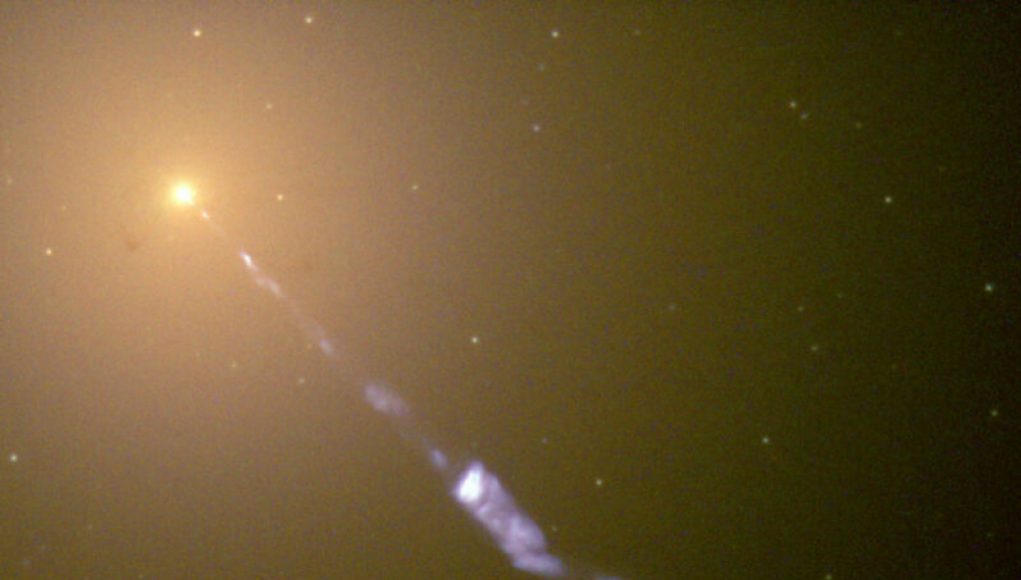Recycling isn’t just for Earth – it seems that some galaxies are doing it too! Scientists have discovered that a massive galaxy within the MAMMOTH-1 nebula is drawing in material from its surroundings to create new stars. But here’s the twist: the material contains elements formed by past supernovae, which were flung into the nebula by the galaxy’s central black hole. This means that the galaxy, known as G-2, is now forming stars from material that had previously been hurled out into intergalactic space by either itself or another nearby galaxy. Talk about recycling stellar style!
Stars are fueled by nuclear fusion, which smashes atoms of hydrogen together into helium. Only massive stars go supernova, after they have fused all their hydrogen into helium. The remains of the dead star scatter into space, swirling into the interstellar medium. While some of this material is lost to space, stars can still potentially incorporate some of the material created in the supernova. The heavier elements created by supernovae can act as tracers for when stars have incorporated the remains of a previous generation of stars.
Raw material for star formation is abundant in the MAMMOTH-1 nebula, and observations from the Subaru and Keck II telescopes have revealed three gaseous streams flowing from the nebula into one of the galaxies inside it. These streams could supply the galaxy with what it needs for a new generation of stars. The research team created kinematic models of both the galaxy and nebula to see exactly how the gaseous streams were moving. It appears the streams are spiraling inward towards the galaxy, which is more evidence for an immense material that can be recycled into new stars.
The presence of carbon in the streams shows that the cloud contains heavier elements that had likely come from stars that have long since died. Two of the streams of gas headed toward the galaxy pulling them in originated from the same quasar. Quasars develop when supermassive black holes at the center of galaxies devour enough material to emit jets of material and extreme radiation. These jets can eject material from the galaxy entirely. The researchers determined this quasar is most likely not located in the same galaxy that’s drawing in the material. So, this appears to be a case where one galaxy is recycling the material cast off from another. It’s fascinating to see how recycling happens even in the vast expanse of space!
A new study has found that galaxies are actively engaging in a form of recycling process, observed for the first time.
The study, published in the Monthly Notices of the Royal Astronomical Society, documents the “recycling” of gas from older stars that are stripped away to the surfaces of galaxies and form new stars, demonstrated in 47 galaxies observed with the Hubble Space Telescope.
The recycled gas provides a new source of fuel for star formation, significantly impacting the galaxies’ star formation and evolution. The observed recycling of gas occurs on an extremely fast timeline of only 10 million years, much faster than the slow process of recently postulated cold gas inflows to a galaxy.
Led by researchers from the University of Massachusetts and Oxford University, the study further explains several previous observations of gas-rich, spiral galaxies, including a surplus of low-metallicity gas observed in their disks. Metals, such as carbon, nitrogen, oxygen and iron, play essential roles in star formation and the interstellar medium.
“The current findings mean that we have to further reassess theories of galaxy formation and evolution,” said Samir Salim, co-author of the study and professor of astronomy at the UMass Amherst College of Natural Sciences.
The researchers suggest that many of these observed galaxies, including our own Milky Way, have been significantly shaped by a continuous cycle of gas recycling. Thus, this swift process might be the defining process in their evolution.
“This recycling process has a huge impact not only on how galaxies form stars today, but also on their past star formation history,” said Joop Schaye, co-author of the study and Professor of Astronomy at Leiden University.
The scientists will be continuing their research to characterize the extent of this process in different types of galaxies in the nearby Universe. They hope to gain further insight into how galaxies form and evolve over time.




















